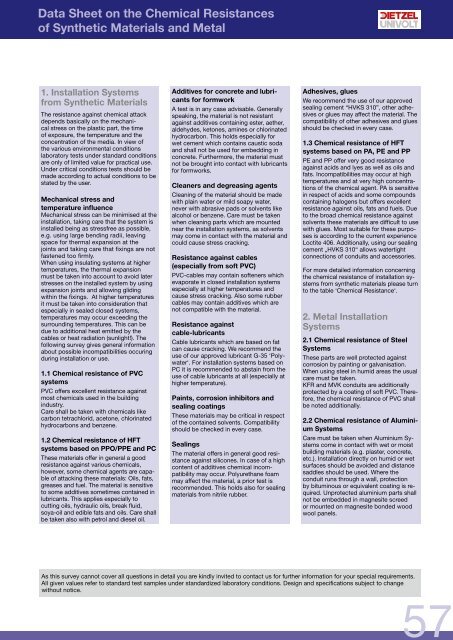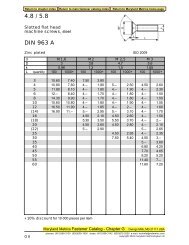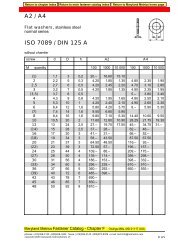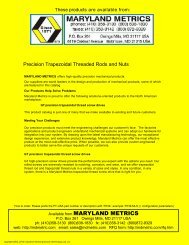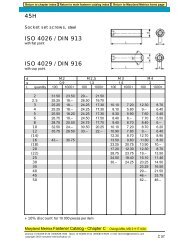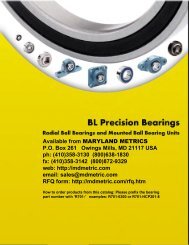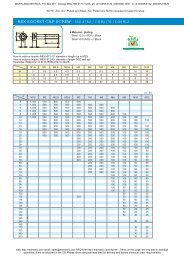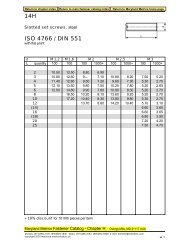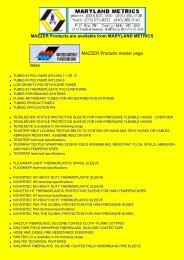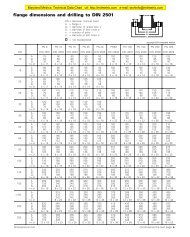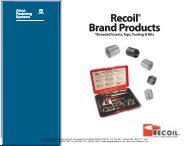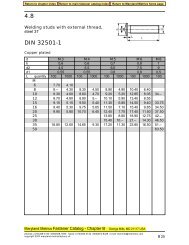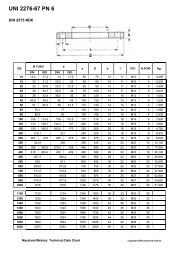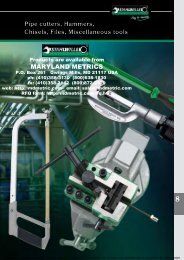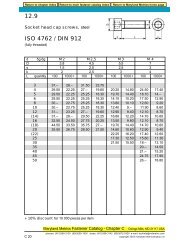Zubehör - Maryland Metrics
Zubehör - Maryland Metrics
Zubehör - Maryland Metrics
Sie wollen auch ein ePaper? Erhöhen Sie die Reichweite Ihrer Titel.
YUMPU macht aus Druck-PDFs automatisch weboptimierte ePaper, die Google liebt.
Data Sheet on the Chemical Resistances<br />
of Synthetic Materials and Metal<br />
1. Installation Systems<br />
from Synthetic Materials<br />
The resistance against chemical attack<br />
depends basically on the mechanical<br />
stress on the plastic part, the time<br />
of exposure, the temperature and the<br />
concentration of the media. In view of<br />
the various environmental conditions<br />
laboratory tests under standard conditions<br />
are only of limited value for practical use.<br />
Under critical conditions tests should be<br />
made according to actual conditions to be<br />
stated by the user.<br />
Mechanical stress and<br />
temperature influence<br />
Mechanical stress can be minimised at the<br />
installation, taking care that the system is<br />
installed being as stressfree as possible,<br />
e.g. using large bending radii, leaving<br />
space for thermal expansion at the<br />
joints and taking care that fixings are not<br />
fastened too firmly.<br />
When using insulating systems at higher<br />
temperatures, the thermal expansion<br />
must be taken into account to avoid later<br />
stresses on the installed system by using<br />
expansion joints and allowing gliding<br />
within the fixings. At higher temperatures<br />
it must be taken into consideration that<br />
especially in sealed closed systems,<br />
temperatures may occur exceeding the<br />
surrounding temperatures. This can be<br />
due to additional heat emitted by the<br />
cables or heat radiation (sunlight!). The<br />
following survey gives general information<br />
about possible incompatibilities occuring<br />
during installation or use.<br />
1.1 Chemical resistance of PVC<br />
systems<br />
PVC offers excellent resistance against<br />
most chemicals used in the building<br />
industry.<br />
Care shall be taken with chemicals like<br />
carbon tetrachlorid, acetone, chlorinated<br />
hydrocarbons and benzene.<br />
1.2 Chemical resistance of HFT<br />
systems based on PPO/PPE and PC<br />
These materials offer in general a good<br />
resistance against various chemicals,<br />
however, some chemical agents are capable<br />
of attacking these materials: Oils, fats,<br />
greases and fuel. The material is sensitive<br />
to some additives sometimes contained in<br />
lubricants. This applies especially to<br />
cutting oils, hydraulic oils, break fluid,<br />
soya-oil and edible fats and oils. Care shall<br />
be taken also with petrol and diesel oil.<br />
Additives for concrete and lubricants<br />
for formwork<br />
A test is in any case advisable. Generally<br />
speaking, the material is not resistant<br />
against additives containing ester, aether,<br />
aldehydes, ketones, amines or chlorinated<br />
hydrocarbon. This holds especially for<br />
wet cement which contains caustic soda<br />
and shall not be used for embedding in<br />
concrete. Furthermore, the material must<br />
not be brought into contact with lubricants<br />
for formworks.<br />
Cleaners and degreasing agents<br />
Cleaning of the material should be made<br />
with plain water or mild soapy water,<br />
never with abrasive pads or solvents like<br />
alcohol or benzene. Care must be taken<br />
when cleaning parts which are mounted<br />
near the installation systems, as solvents<br />
may come in contact with the material and<br />
could cause stress cracking.<br />
Resistance against cables<br />
(especially from soft PVC)<br />
PVC-cables may contain softeners which<br />
evaporate in closed installation systems<br />
especially at higher temperatures and<br />
cause stress cracking. Also some rubber<br />
cables may contain additives which are<br />
not compatible with the material.<br />
Resistance against<br />
cable-lubricants<br />
Cable lubricants which are based on fat<br />
can cause cracking. We recommend the<br />
use of our approved lubricant G-35 ‘Polywater‘.<br />
For installation systems based on<br />
PC it is recommended to abstain from the<br />
use of cable lubricants at all (especially at<br />
higher temperature).<br />
Paints, corrosion inhibitors and<br />
sealing coatings<br />
These materials may be critical in respect<br />
of the contained solvents. Compatibility<br />
should be checked in every case.<br />
Sealings<br />
The material offers in general good resistance<br />
against silicones. In case of a high<br />
content of additives chemical incompatibility<br />
may occur. Polyurethane foam<br />
may affect the material, a prior test is<br />
recommended. This holds also for sealing<br />
materials from nitrile rubber.<br />
Adhesives, glues<br />
We recommend the use of our approved<br />
sealing cement “HVKS 310”, other adhesives<br />
or glues may affect the material. The<br />
compatibility of other adhesives and glues<br />
should be checked in every case.<br />
1.3 Chemical resistance of HFT<br />
systems based on PA, PE and PP<br />
PE and PP offer very good resistance<br />
against acids and lyes as well as oils and<br />
fats. Incompatibilities may occur at high<br />
temperatures and at very high concentrations<br />
of the chemical agent. PA is sensitive<br />
in respect of acids and some compounds<br />
containing halogens but offers excellent<br />
resistance against oils, fats and fuels. Due<br />
to the broad chemical resistance against<br />
solvents these materials are difficult to use<br />
with glues. Most suitable for these purposes<br />
is according to the current experience<br />
Loctite 406. Additionally, using our sealing<br />
cement „HVKS 310“ allows watertight<br />
connections of conduits and accessories.<br />
For more detailed information concerning<br />
the chemical resistance of installation systems<br />
from synthetic materials please turn<br />
to the table ‘Chemical Resistance‘.<br />
2. Metal Installation<br />
Systems<br />
2.1 Chemical resistance of Steel<br />
Systems<br />
These parts are well protected against<br />
corrosion by painting or galvanisation.<br />
When using steel in humid areas the usual<br />
care must be taken.<br />
KFR and MVK conduits are additionally<br />
protected by a coating of soft PVC. Therefore,<br />
the chemical resistance of PVC shall<br />
be noted additionally.<br />
2.2 Chemical resistance of Aluminium<br />
Systems<br />
Care must be taken when Aluminium Systems<br />
come in contact with wet or moist<br />
building materials (e.g. plaster, concrete,<br />
etc.). Installation directly on humid or wet<br />
surfaces should be avoided and distance<br />
saddles should be used. Where the<br />
conduit runs through a wall, protection<br />
by bituminous or equivalent coating is required.<br />
Unprotected aluminium parts shall<br />
not be embedded in magnesite screed<br />
or mounted on magnesite bonded wood<br />
wool panels.<br />
As this survey cannot cover all questions in detail you are kindly invited to contact us for further information for your special requirements.<br />
All given values refer to standard test samples under standardized laboratory conditions. Design and specifications subject to change<br />
without notice.<br />
57


